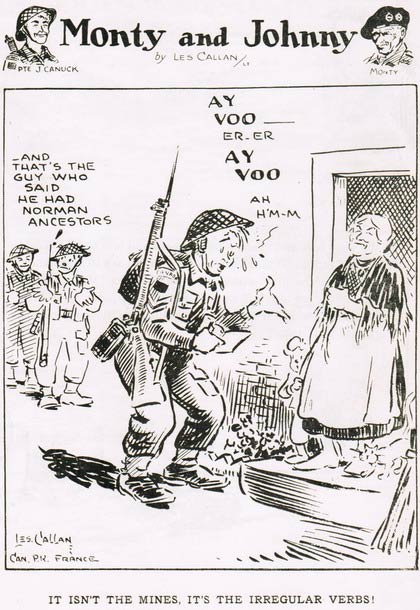'Monty and Johnny'.
Les Callan was a mid-20th century Canadian political cartoonist, active for the Vancouver Sun and the Toronto Star. During World War II, he enlisted in the Canadian army and made numerous cartoons and illustrations depicting his fellow soldiers. His best-known gag cartoon series was 'Monty and Johnny' (1944-1945).
Life and career
Les Callan was born in 1905 in Ignace, near Ontario, Canada. From an early age, he enjoyed drawing cartoons of his classmates at school. After leaving school, he worked at a rail yard, following an evening course in art. In 1926, Callan moved to Chicago to study at the local Academy of Art and a school not far away which specialized in cartooning. His graphic career took off when he became a freelance editorial cartoonist at the Winnipeg Free Press. Between 1928 and 1937, he worked at the Vancouver Sun, after which Joseph E. Atkinson, founder and publisher of the Toronto Star, personally asked him to join his paper instead. Between 1937 until 1961, Callan would remain the Toronto Star's political cartoonist.
Monty and Johnny
In 1940, World War II broke out. Callan's brother joined the Royal Canadian Air Force, while Callan himself enlisted in the Reserve Army. Two years later, he moved up to the Artillery. He fought along with the troops as they moved ahead in France, Belgium, the Netherlands and eventually to Berlin, Germany. On 2 January 1944, a daily newspaper was established for the Canadian troops: The Maple Leaf. Its staff consisted mostly of soldiers with experience in the press industry. The publication not only contained news from the front and at home, but also features from Canadian newspaper syndicates, pin-up photos, letters, poems and cartoons. Bing Coughlin had a cartoon series starring 'Herbie'. Other cartoonists who drew for the paper were Merle "Ting" Tingley, Ted "The Moaner" Reeve, L.E. Weekes, Tom Luzny and Les Callan. Callan had a gag cartoon series in the Northwest Europe edition of the paper named 'Monty and Johnny'. Monty referred to British general Bernard Montgomery, while Johnny was the nickname for the common Canadian soldier. The cartoons mostly ran between 1944 and 1945 and referred to various actual events at the time.
'Normandy and On... From D-Day to Victory'.
On the Road to Berlin
In 1944-1945, Callan also drew more serious illustrations for The Maple Leaf, such as 'On the Road to Berlin', which were portraits of Canadian soldiers with descriptions of their occupation and hometown, based on talking directly with his fellow soldiers. After the war, these cartoons were collected in the book 'Normandy and On... From D-Day to Victory' (1945, Longmans, Green and Co.). In the foreword, Callan wrote: "The Canadian soldier is a grand fighting man with a keen sense of humor and a great heart. It is my hope that this [work] may in its own modest way add to the record of his achievements and help to keep memories of them fresh."
Final years and death
Callan also ran unsuccessfully for the Canadian House of Commons for the Liberal Party in his home in Scarborough North, before he eventually moved to Vancouver in 1973. He passed away in 1986.
Political cartoon from The Toronto Star, referencing the 30 November 1938 broadcast of Orson Welles' radio play 'War of the Worlds' about a Martian invasion, which caused a minor panic among certain listeners, exaggerated by newspapers at the time into mass hysteria, making Welles world famous overnight.






